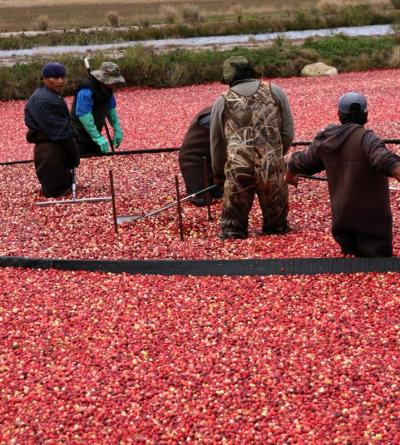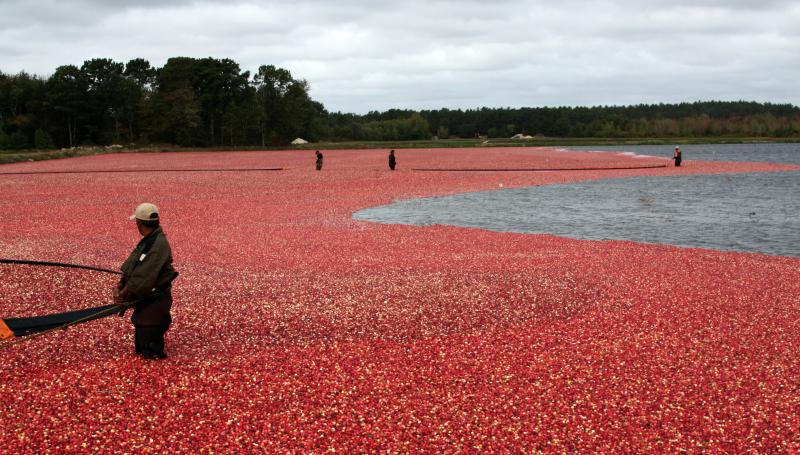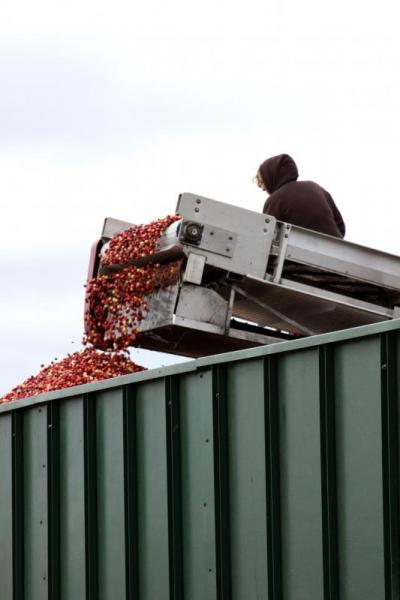A harvest tradition, that is anything but traditional



Scroll down for a cranberry harvest video!
For many of us less observant residents of Wareham, the cranberry industry is one of those things that we don't really understand, but we pretend to know about in order to impress visitors.
So, to learn about the harvest, we joined George Rogers, a Senior Vice President at A.D. Makepeace, to show us around the bogs of a commercial cranberry operation.
A.D. Makepeace is the largest cranberry grower in the world, harvesting about 1,750 acres of bogs this year, Rogers said. But there is quite a difference between the cranberries that you see on the Makepeace bog, and the Makepeace cranberries that go into your belly.
And although we associate cranberry products with tradition, the Makepeace harvest has changed significantly over its nearly 200-year history.
A.D. Makepeace "wet picks," its berries, a process introduced in the 1970s that requires flooding the bogs before beating berries off the vine and corralling them to be collected. (To learn more about the process, see photos)
"With wet picking, you can just go-go-go," Rogers said, explaining that it requires less labor by mechanizing the picking process, resulting in a more efficient use of labor.
But it results in slightly battered fruit, which is processed into food products like sauce and juices rather than sold as ripe fruit which is picked by hand.
It also requires more water - a precious commodity for cranberry growers.
So the bogs are changing too.
"At A.D. Makepeace, there's a major effort to rebuild bogs," said Rogers. "We're going to be at this a long time, so we're pumping a lot of money back into our farms."
Traditional bogs were basically just flooded stream beds, with cranberries planted to spread over the existing topography.
Today, bogs are surveyed with lasers to be level, saving water by ensuring that the flooded water is at a consistent depth of six to eight inches rather than at six inches over the "shallow end" of the bog. Sprinklers, pumps, and extensive network of dikes, ponds and canals control watering and flooding rather than dams, and irrigation is automated in response to computerized readings of conditions on the bog.
Bogs also have different cranberries now than in the past. One new variety of cranberry, called the Rutgers, produces a yield of 400 barrels of berries per acre, twice as many barrels per acre as other varieties. And while bogs once had several different types of berries that ripened at different times in the season, each bog now usually contains just a single type which allows higher yields at different times of year.
And these shifts require many more workers than just farmers. There are engineers, mechanics, electricians, pickers, equipment operators, and many types of contractors that are frequently out on the bog.
First contractors clear and level the land. They separate the soil into different grades for use in building the bogs and supporting ponds, ditches, etc., and sell some to be used for mixing cement or create other products.
The bog and its surrounding infrastructure, including irrigation systems is then designed by engineers and constructed with a mixture of topsoil and sand. The farmers then come in and fertilize the soil to become acidic and plant the bogs with cranberries. As the vines lengthen, sand is added to weigh them down so they can sprout new roots and thicken the foliage, establishing a "canopy" of vines that shades the plants roots, better retains moisture, and helps protect the berries from scalding by the sun.
Rogers said that about a quarter of A.D. Makepeace's 2,100 total acreage is rebuilt or in the three-year-long process of rebuilding, with a company goal to rebuild approximately 100 acres a year.
As he said, they're in it for the long haul.













